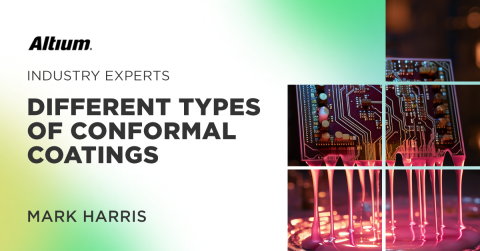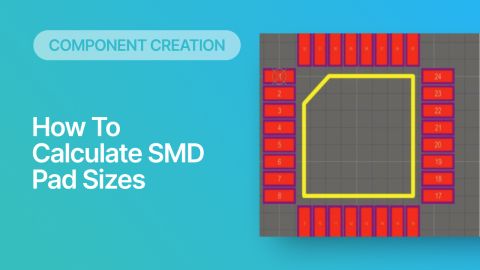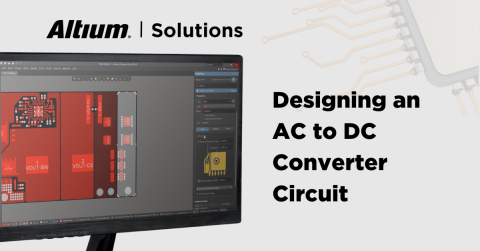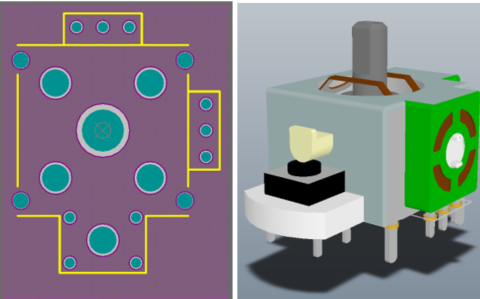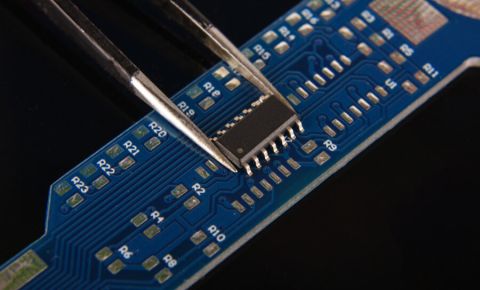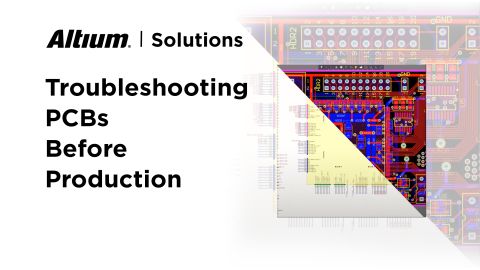Designing 5G PCB Devices

The next stage in the evolution of mobile telephony is here with the roll-out of 5G. The designer looking to incorporate functionality to handle 5G signals into their circuits will face some challenging issues. So, what’s so special about 5G? The main change in the jump from 4G to 5G is the frequency band at which signals are transmitted. For 4G, this band covered 0.7 GHz up to 2.5 GHz. For 5G, this new band is an order of magnitude larger, with the US’s high bands being centered around 28 GHz, 38 GHz, and 67 GHz. This fits in the spectrum between radio waves and microwaves, where conductivity gets complicated, but we’ll get to that shortly.
However, the carrier frequency isn’t the only challenge for the designer, the channel bandwidth available for data transmission has also significantly increased. In the previous fourth-generation systems, channel bandwidth was 20 MHz, although IoT devices were limited to just 200 kHz. Now with 5G, the channel bandwidth is up to 400 MHz.
The higher carrier frequency and channel bandwidth benefits are faster data transfer speeds and lower data latency, which is perfect for streaming multimedia. Also, it allows connectivity for a vastly larger number of devices, potentially a million per square kilometer. This opens up the possibility of the Internet of Things shifting to use 5G as their preferred connection choice. The downside is the complexity it adds to the devices that need to handle these frequencies, but then all good designers love a challenge… don’t we?
Signal Management
Signal degradation as a result of reflections on signal traces becomes a more significant issue. This issue has previously been discussed in the article on the transmission line reflection coefficient, and handling signals in the 27 GHz to 71 GHz range will exacerbate these issues. At these frequencies, reflections can be problematic on reasonably short transmission line lengths. The board design must use correctly terminated signal lines and impedance matching to prevent signal reflections and associated superposition effects resulting in ringing. It is also crucial that traces are manufactured with constant trace-width and spacing to maintain constant impedance to eliminate any reflection points along the traces. This places restrictions on the use of vias; if they extend past signal traces through unused layers, they can create a step-change in impedance along a signal path and cause significant reflections.
The levels of electromagnetic interference (EMI) caused by the high-frequency 5G signals on the rest of the circuit will also be increased. Capacitive and inductive coupling are respectively proportional to the rates of change of voltage and current, requiring more thorough considerations of signal routing and shielding for board design. Capacitive coupling is managed through the use of shielding, around the source signal line, any susceptible signal lines, or ideally both. Inductive coupling is managed through the use of appropriate trace separation. The key factors to take into account in the design is to minimize the length of traces where 5G signals travel in proximity to susceptible signals lines, implement differential signals wherever possible, correctly shield and ground signals using grounded guard traces and if the layout allows, run 5G signal traces and susceptible signals lines on different layers and perpendicular to each other rather than parallel. Handling 5G will predicate the use of multilayer PCBs to allow buried ground and power supply planes to be used to prevent capacitive coupling effects and provide low inductance return paths.
When handling high-frequency 5G signals, conductivity becomes a significant factor thanks to the skin effect. For direct current flow, all electrons within the conductor carry the charge, so the conductivity is a factor of the material and volume. Hence, thick copper wires are more conductive than thin aluminum wire. When you move to alternating current flow, an effect is seen where only the electrons within a set distance from the conductor’s surface carry the charge. The higher the frequency, the shorter this distance, and hence the smaller the volume of the material that is conducting. At the very high frequencies that 5G uses, this depth from the surface is relatively tiny, hence the term skin effect; it’s just the conductor’s skin that carries all the current. So, for DC, the volume of material used to calculate conductivity is the conductor area multiplied by its length. For very high frequencies, the volume of material used to calculate conductivity is simply the conductor’s surface area. This has the advantage that if you need to carry high frequencies over long distances, you can make each conducting wire from a cheap and light non-conducting material with a thin, highly conductive coating. Bundling up thousands of such wires gives an impressively sizable conductive surface area much cheaper and lighter than the equivalent low-frequency cabling (note this may not work if the signal includes a low-frequency or DC component). The issue for the PCB designer is there’s much less scope to optimize surface area within the constraints of the board design. Still, advanced manufacturing techniques such as the semi-additive fabrication process (mSAP) technique could be considered to create 3D trace shaping that increases surface area. Ideally, traces should be perfectly regular in cross-section as at high frequencies, any irregularities in the trace surface can decrease conductivity.
Thermal Management
A factor that is always important for the board designer is thermal management, though more commonly associated with power delivery than signal frequency. A new feature that 5G brings to signal reception and transmission over the previous generations is the use of massive multiple-input multiple-output (MIMO) technology for directional signal control. 5G relies on the use of beamforming technology to direct signal transmission in order to realize its operational capabilities. Cell towers use multiple targeted beams to connect to individual user devices as opposed to the traditional approach where a cell tower floods the immediate area with undirected transmissions. The MIMO technology is implemented as an array of at least sixteen antennas arranged in a square, which for this minimum example would be four by four. Sixteen is considered the minimum based on eight transmit and eight receive antennas. Typically, it is expected that a 5G cell tower would actually use hundreds of individual antennas in practical applications and the end device would have fewer. These multiple antennas implement the required adaptive beamforming for transmissions to and from cell towers. Each antenna requires its own radio-frequency (RF) transceiver, and the nature of high-frequency signals that we’ve already discussed necessitates that these are all co-located in a single densely packed component. The MIMO technology consumes significant power levels, resulting in significant heat energy levels generated in a relatively small area requiring careful thermal management. However, with the high-frequency signals present in this area of the board, the designer will need to be mindful of the need to balance thermal management requirements with EMI management requirements.
Another factor in thermal management is the increasing use of Gallium Nitride (GaN) based substrates in 5G devices due to their ability to handle higher power levels efficiently at the high frequencies involved relative to the more transition silicon-based substrates. The downside of GaN is that its RF performance becomes limited when put under heat stress in addition to the usual reliability issues for all components, making effective thermal management important. The introduction of 5G may make traditional natural convection-based cooling strategies ineffective and necessitate the use of forced-air cooling or liquid-cooling technologies as part of the device design.
It is worth mentioning that as 5G components are being developed, integrated cooling within these components is being considered, which could make the designer’s thermal management task a little easier. Current research includes embedded cooling mechanisms using a heat-extracting dielectric fluid that flows within the die in channels of around 100 μm to extract heat to the outside of the component where it can be more efficiently conducted away using traditional thermal management techniques. This exciting development also offers a potential solution for the cooling of stacked dies within a chip.
PCB substrate
PCBs commonly use composite materials such as fiberglass or composite epoxy for their substrate material. When dealing with high frequencies, materials such as FR4-grade glass-reinforced epoxy laminate, polyphenylene oxide resin, and polytetrafluoroethylene (PTFE) are required. With 5G comes the requirement for the designer to take into account the properties of the substrate material as part of their design decisions. The metrics for dielectric loss, heat resistance, and thermal expansion will all be crucial. Selecting the right board requires a low dielectric constant and high thermal conductivity. A substrate with high thermal conductivity is required to spread and dissipate the heat produced by the RF components. A low coefficient of dielectric constant is also required to ensure signal propagation speeds and signal reflections are not affected by thermal effects.
The thickness of the laminate is also essential; if too thin, there is a risk that high-frequency signals can resonate between layers. The rule of thumb usually applied is that the laminate thickness should be approximately around a quarter or an eighth of the wavelength for the highest operating frequency.
Conclusions
The design of 5G devices raises challenges with managing high-speed and high-frequency signals to prevent signal degradation and EMI generation and thermal management challenges. As technology develops, standard solutions and component sets will become increasingly available at lower prices that will drive the adoption of 5G for more and more devices. Once the IoT has fully embraced 5G, the design of 5G circuits will become more commonplace, and these challenges will seem far less intimidating. No doubt, at this time, we’ll be worrying about 6G, which is only expected to be about a decade away from commercial availability.
The design tools in Altium Designer® contain everything you need to keep up with new technology. Talk to us today and find out how we can enhance your next PCB Design.
